Reverse Sear New York Strip
The perfectly even doneness of a reverse seared New York strip steak makes every single bite a mouthwatering slice of heaven.
Reverse-seared steaks can be started in the oven and finished either on the stove or on the grill. Or they can be cooked using only the grill. Full directions for both methods are included below.
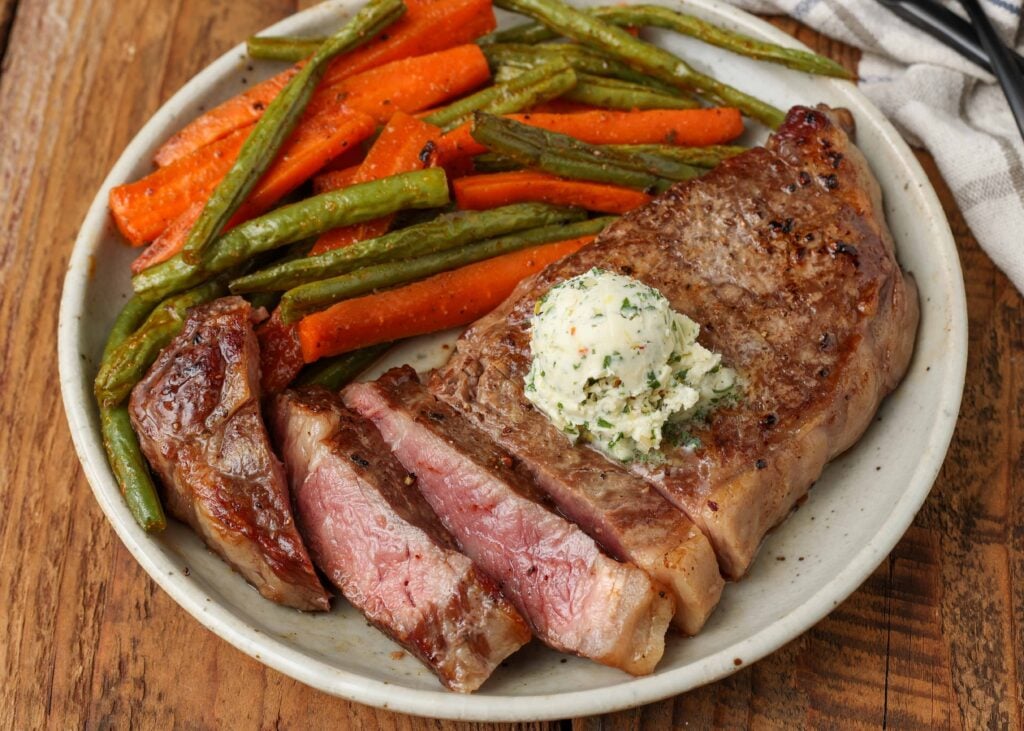
Reverse Seared Steak
Oh my goodness, this was the BEST steak ever cooked in our home, or technically, in our backyard. After doing a bit of research, my husband wanted to try the reverse sear technique.
Edited to add: We’ve been reverse searing steaks for over ten years now and swear by this method as the best and only way to ensure perfectly cooked steaks every single time.
Are you reading this wondering, “what is reverse searing?” It sounded pretty weird to me too the first time I saw it mentioned.
Contrary to conventional methods, reverse searing simply means roasting the meat very slowly at low temp first and then searing it at the end. This method delivers the most evenly cooked steaks you can imagine.
How to Reverse Sear a Steak
The first time we reverse seared steaks we followed the directions from Chris over at Nibble Me This and we were absolutely thrilled. My middle son, who had never been excited about eating steak, even asked for seconds. I could hardly believe what a difference the reverse sear technique made!
Over the years, I’ve followed the tips and advice over at Serious Eats and figured out how to reverse-sear steaks in the oven for an even easier and faster path to perfectly cooked steaks.

What is Reverse Sear?
What exactly is reverse searing? The method is called reverse searing because it is the reverse of all historic methods for cooking steak. For countless years, almost every recipe or chef has told us that the first step when cooking meats should be searing.
We’ve been taught that this “locks in juices.” But now? We know that we aren’t locking in juices at all. What searing does do is add flavor, and that’s an important step that we don’t want to skip. However, there’s no need for it to be the first step.

Reverse Sear New York Strip
Reversing the process so that the searing comes at the end delivers a more delicious and perfectly cooked result. When cooked slowly with low heat, the temperature builds up slowly inside the meat. The result is a more evenly cooked steak.
Conversely, when steaks are cooked over high heat, the meat will cook faster, but unfortunately, it also tends to cook less evenly. By starting the steak over indirect heat on the grill or in a low-temperate oven, the result is a much juicier steak with no overcooked portions of meat.
When you’re in a hurry and craving steak, try steak bites for perfectly cooked bites of steak that are done over high heat in just a few minutes. If you’re a mushroom-lover, buttered steak bites with mushrooms are a winner too. And for something a little different? Asian steak bites are always a hit.
But for a full-size New York strip steak? Take the time to do a reverse sear and you’ll revolutionize your steak game.
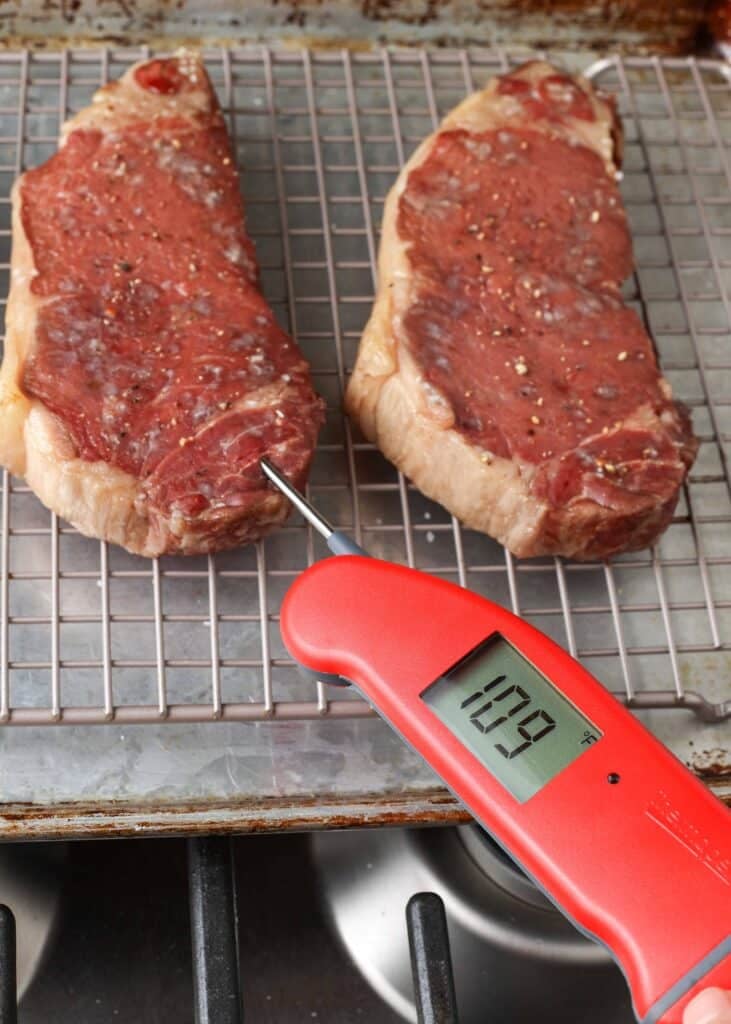
Thermometers for Steak
When cooking steaks in the oven and on the stovetop, I use this handheld digital thermometer. It registers temps fast and is very easy to use.
For an internal thermometer that can be left in the meat throughout the cooking process, this is a great thermometer and I’ve been using mine for over ten years.
Both are fairly inexpensive options for high-quality digital thermometers.
How Long To Reverse Sear Steak
Life lesson here – there isn’t a set time for cooking most steaks. Meat thermometers are going to be your friend.
I’m giving you a list of estimated cooking times for steaks that are approximately 1 ½ inches thick, cooked at 250-275°F. PLEASE use a thermometer and don’t really solely on a timer. Target OVEN temps are listed below along with FINAL temps.
- For rare steaks (target 105°F, final 120°F), it will take between 17-25 minutes.
- For medium-rare steaks (target 115°F, final 130°F), it will take between 22-30 minutes.
- For medium steaks (target 125°F, final 140°F), it will take between 27-35 minutes.
- For medium-well steaks (target 135°F, final 150°F), it will take between 32-40 minutes.
PLEASE NOTE: The steaks photographed here were closer to 1 ¼ inches thick and the total cooking time for barely medium-rare was around 20 minutes. My target temp, as pictured below, was about 110°F and my final temp was about 125°F.
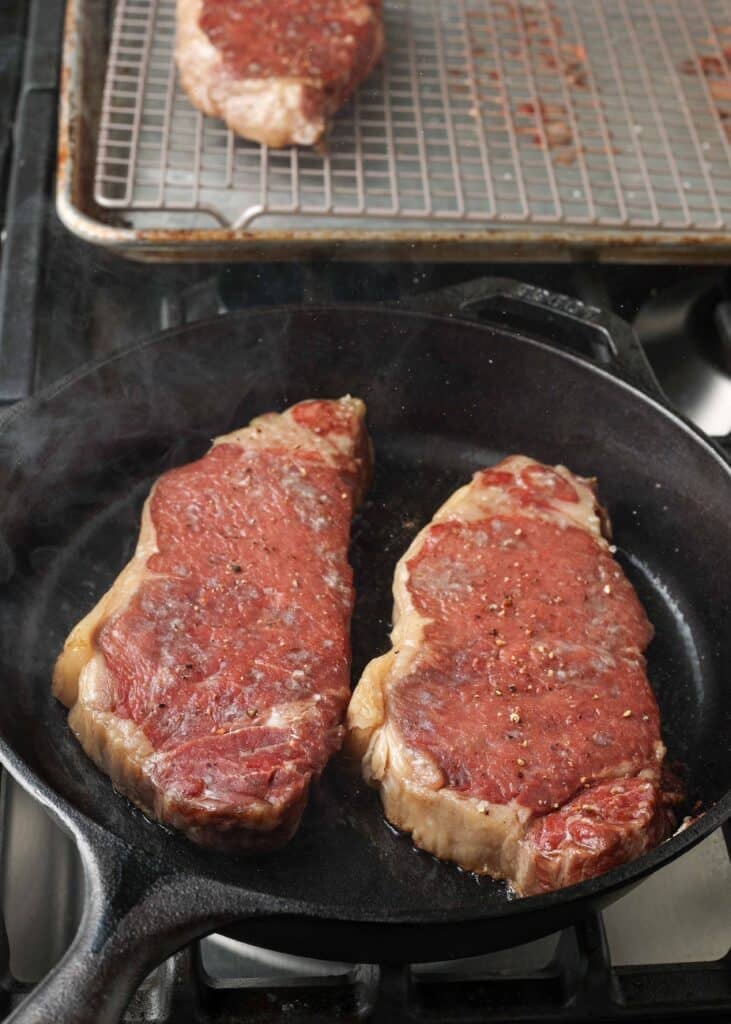
Reverse Sear Steak in Oven
- Place a wire rack over a rimmed sheet pan. Set the steaks on the wire rack and sprinkle both sides with salt and pepper.
- Preheat the oven to 275°F. Place the steaks in the oven and cook until an instant-read thermometer registers 105°F for rare, 115°F for medium-rare, 125°F for medium, or 135°F for medium-well.
- This will take about 12-20 minutes for rare steaks and up to 40 minutes for medium-well, depending on the thickness of your steaks. Cooking times can and do vary greatly depending on many factors, so check the steaks frequently to avoid overcooking.
- Just before the steaks come out of the oven, add 1 tablespoon of oil to a cast iron or heavy stainless steel skillet. Heat over high heat until smoking. Add butter, if desired, and swirl the pan to melt. Add steaks to the skillet and cook until each side is well browned, about 40-45 seconds per side.
- Using tongs, hold each steak on its side to sear the edges. Remove from the skillet and let them rest for a couple of minutes prior to serving. There’s no need for an extended rest with reverse seared steaks.
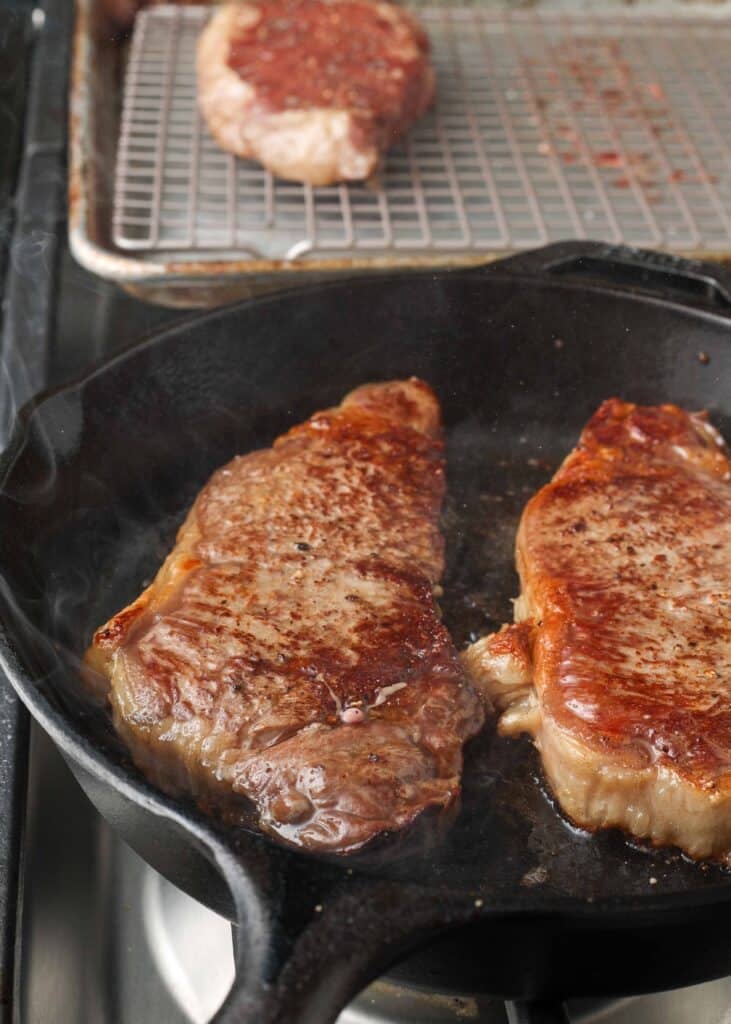
Reverse Sear Steak on Grill
- Place the steaks on a plate or baking sheet and sprinkle both sides with salt and pepper. Leave on the counter to warm slightly while the grill is heating. Place an internal thermometer in one of the steaks.
- Set up your grill for an indirect cook at 250°F. This means turning on one burner and leaving the others off while the lid is CLOSED. We set an oven thermometer inside the grill on the plates farthest from the heat. This is where the steaks were going to be cooked.
- When the thermometer registers 250°F, add the steaks to the grill. Set the thermometer to the side and CLOSE the grill. Cook the steaks over the indirect heat until the internal temperature is 125°F. This took 45 minutes for our steaks, but watch the thermometer not the clock, because the steaks are cooking by temperature, not time.
- Crank the heat to high for a few minutes with the grill OPEN, then move the steaks over the direct heat for just about 1 minute on each side. Remove from the grill and let them rest for a couple of minutes prior to serving. There’s no need for an extended rest with reverse seared steaks.

Any number of different rubs or seasoning combinations will work beautifully on reverse seared steaks. However, with nothing more than a bit of salt and pepper, these steaks absolutely rock. I can hardly wait to make them again.
Loaded with my most frequently used spices, this all-purpose seasoning blend is always worthy of space in my spice cabinet – although, if I’m honest, it’s on the counter more often than in the cabinet most days.
Skip the store-bought spice mix and make your own Cajun seasoning. I first shared this recipe in The Weeknight Dinner Cookbook several years ago. This seasoning mix has been a staple in my spice cabinet ever since. I use it on meats and vegetables on a regular basis.
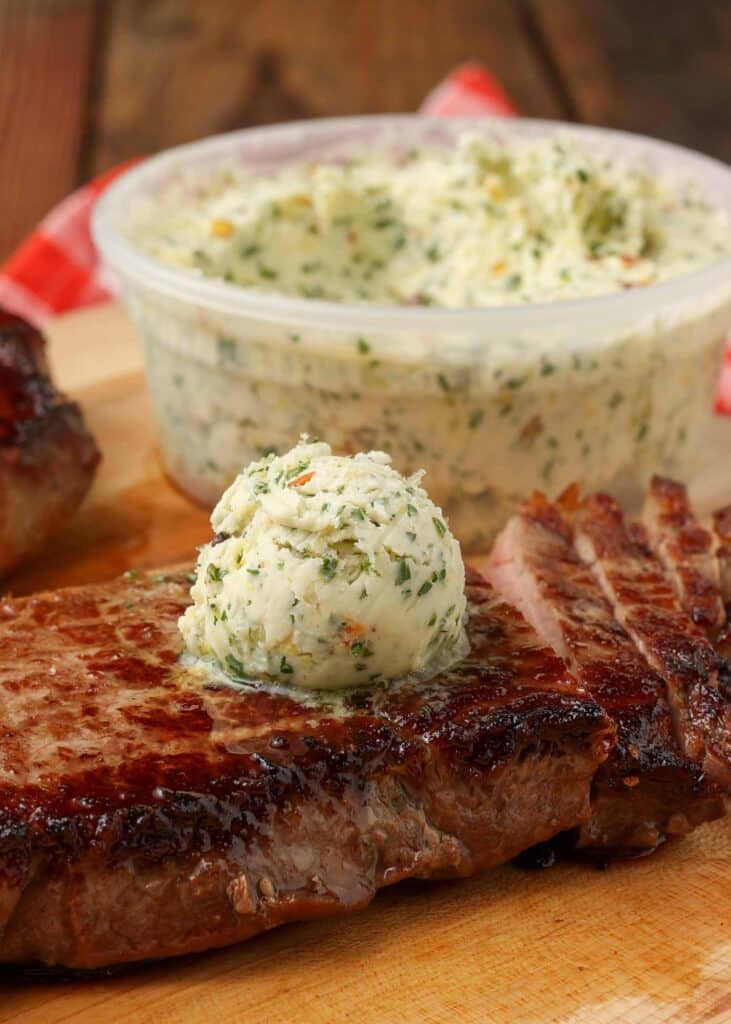
Lastly, I can’t share these steaks without giving mention to the mouthwatering Cowboy Butter that is melting over them. Do yourself a favor and mix this compound butter together.
Loaded with robust garlic, zesty lemon, and a kick of red pepper flakes, Cowboy Butter is absolutely crave-worthy on steak, vegetables, or fresh bread. It’s rapidly become a staple in my refrigerator.
I served these steaks with roasted green beans and carrots that I tossed with the remaining butter. There wasn’t a bite left over.
Print
Reverse Seared Steak
The perfectly even, smoky char of a tender Reverse Sear New York Strip steak makes every single bite a mouthwatering slice of heaven.
Course Main Course
Cuisine American
Prep Time 5 minutes minutes
Cook Time 40 minutes minutes
Total Time 45 minutes minutes
Servings 4
Calories 635kcal
- 2 large NY Strip Steaks about 1¼" thick, approximately 2.5 lbs total weight
- kosher salt adjust to taste
- freshly ground black pepper adjust to taste
- 1 tablespoon light olive oil for stovetop method only
- 1 tablespoon butter for stovetop method only OPTIONAL
Oven and Stove Instructions
Set a wire rack over a rimmed sheet pan. Place the steaks on the wire rack and preheat the oven to 275°F. Place the steaks in the oven and cook until an instant-read thermometer registers 105°F for rare, 115°F for medium-rare, 125°F for medium, or 135°F for medium-well. This will take about 12-20 minutes for rare steaks and up to 40 minutes for medium-well, depending on the thickness of your steaks. Cooking times can and do vary greatly depending on many factors, so check the steaks frequently to avoid overcooking.
Just before the steaks come out of the oven, add 1 tablespoon of oil to a cast iron or heavy stainless steel skillet. Heat over high heat until smoking. Add butter, if desired, and swirl the pan to melt. Add steaks to the skillet and cook until each side is well browned, about 40-45 seconds per side.
Using tongs, hold each steak on its side to sear the edges. Remove from the skillet and let them rest for a couple of minutes prior to serving. There's no need for an extended rest with reverse seared steaks.
Grilling Instructions
Place the steaks on a plate or baking sheet and sprinkle both sides with salt and pepper. Leave on the counter to warm slightly while the grill is heating. Place an internal thermometer in one of the steaks. Set up your grill for an indirect cook at 250°F. This means turning on one burner and leaving the others off while the lid is CLOSED. We set an oven thermometer inside the grill on the plates farthest from the heat. This is where the steaks were going to be cooked. When the thermometer registers 250°F, add the steaks to the grill. Set the thermometer to the side and CLOSE the grill. Cook the steaks over the indirect heat until the internal temperature is 125°F. This took 45 minutes for our steaks, but watch the thermometer not the clock, because the steaks are cooking by temperature, not time.
Crank the heat to high for a few minutes with the grill OPEN, then move the steaks over the direct heat for just about 1 minute on each side. Remove from the grill and let them rest for a couple of minutes prior to serving. There's no need for an extended rest with reverse seared steaks.
Calories: 635kcal | Protein: 58g | Fat: 43g | Saturated Fat: 17g | Polyunsaturated Fat: 2g | Monounsaturated Fat: 18g | Cholesterol: 227mg | Sodium: 147mg | Potassium: 887mg | Calcium: 65mg | Iron: 4mg
{originally published 1/29/12 – recipe notes and photos updated 6/27/23}
grilling instructions from and with thanks to Nibble Me This
oven and stove instructions from and with thanks to Serious Eats
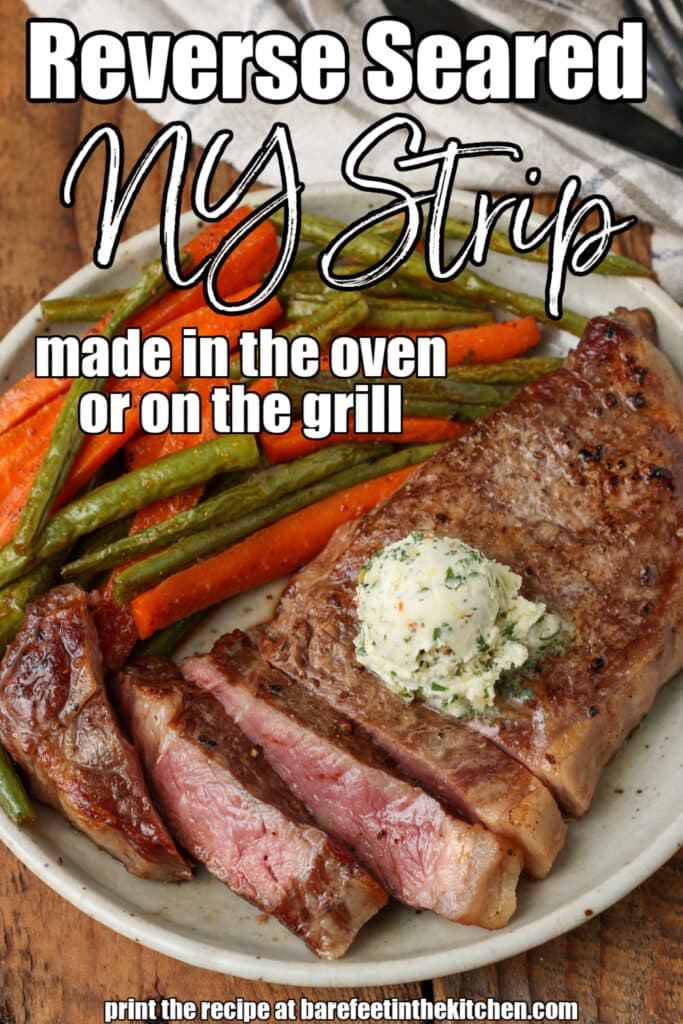
The post Reverse Sear New York Strip appeared first on Barefeet in the Kitchen.